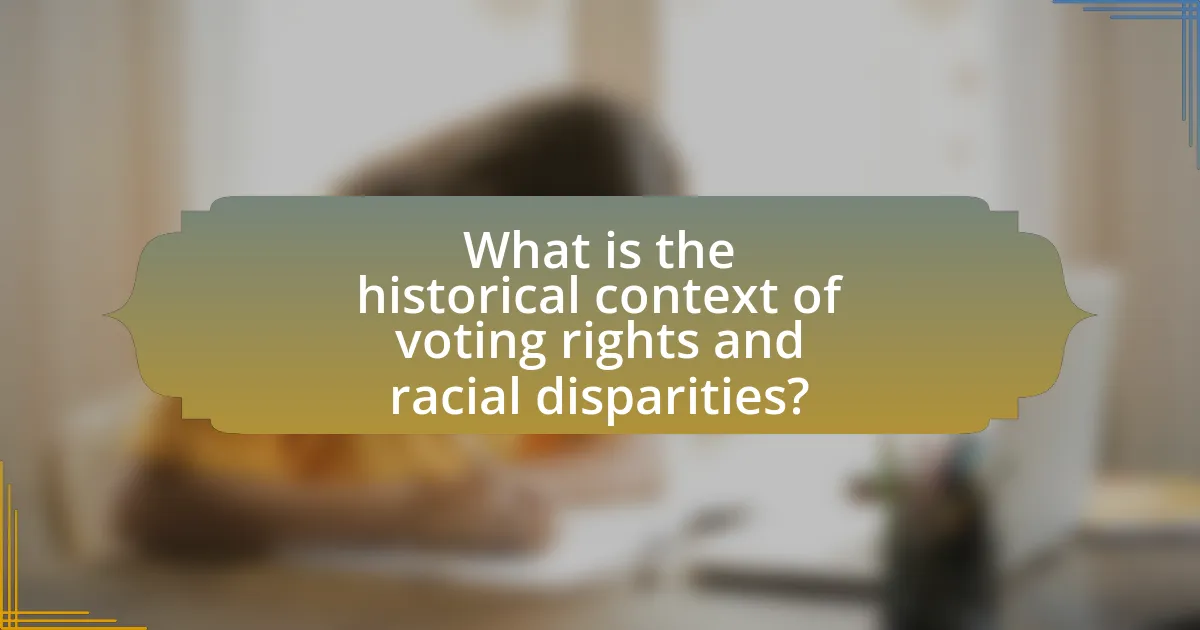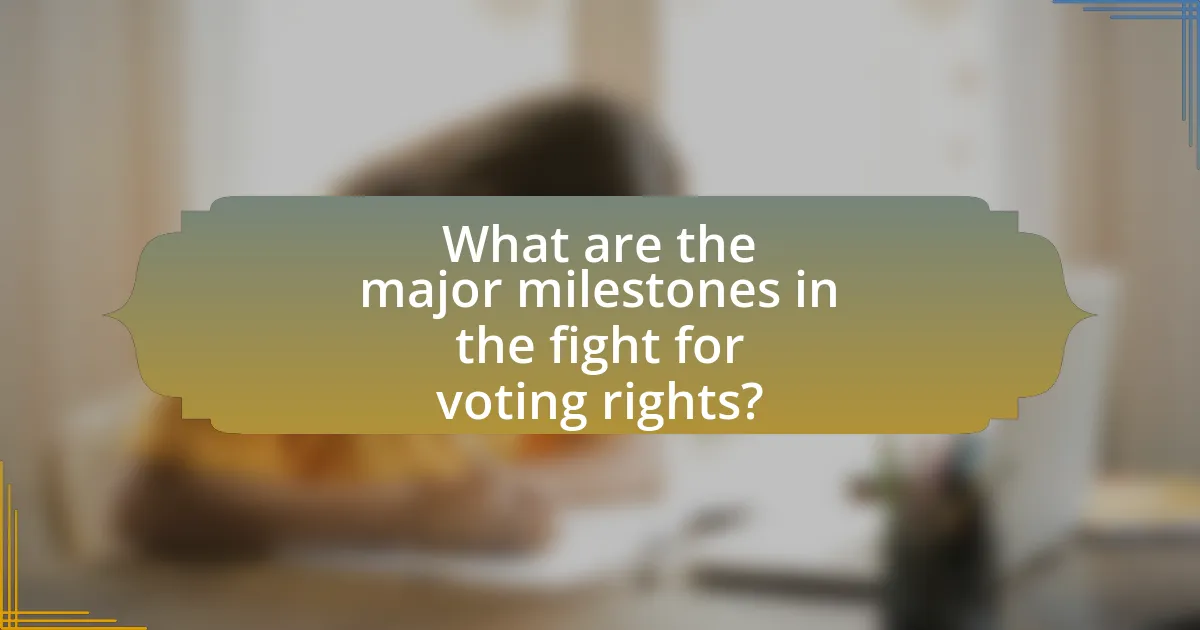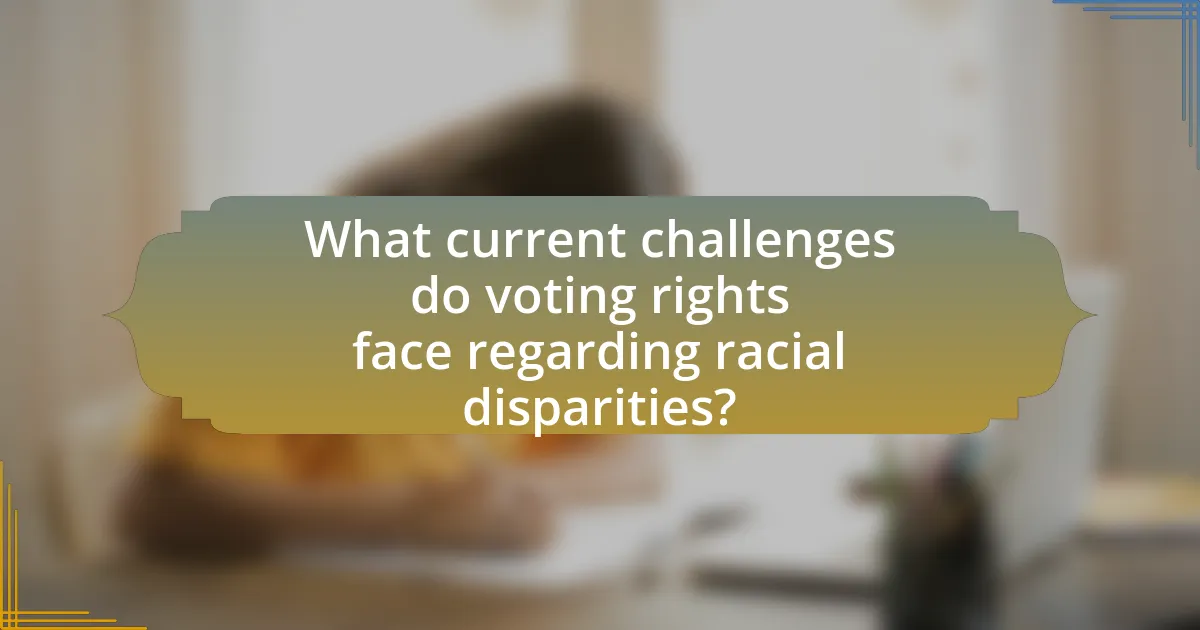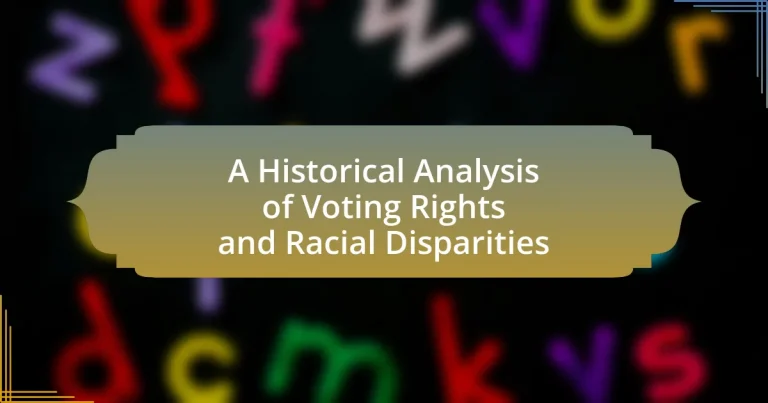The article provides a historical analysis of voting rights and racial disparities in the United States, tracing the evolution of voting access from the founding of the nation to contemporary challenges. It examines systemic discrimination, key legislative milestones such as the Voting Rights Act of 1965, and the impact of various social movements on voting rights advancements. The article highlights the ongoing issues of voter suppression tactics, including voter ID laws and gerrymandering, which disproportionately affect racial minorities. Additionally, it discusses current initiatives aimed at addressing these disparities and the role of advocacy groups in promoting equitable voting access.

What is the historical context of voting rights and racial disparities?
The historical context of voting rights and racial disparities is rooted in systemic discrimination and legislative barriers that have evolved over centuries. Initially, the U.S. Constitution allowed states to determine voting qualifications, leading to widespread disenfranchisement of African Americans and other racial minorities, particularly through mechanisms like literacy tests and poll taxes established in the late 19th century. The Voting Rights Act of 1965 aimed to eliminate these barriers, significantly increasing voter registration and participation among African Americans in the South. However, recent legislative changes and court rulings have raised concerns about the resurgence of racial disparities in voting access, evidenced by studies showing that minority voters still face obstacles such as voter ID laws and purging of voter rolls.
How have voting rights evolved over time in the United States?
Voting rights in the United States have evolved significantly from the founding of the nation to the present day. Initially, voting was largely restricted to white male property owners, but over time, various amendments and legislation expanded suffrage to include a broader population. The 15th Amendment, ratified in 1870, prohibited denying the right to vote based on race, yet discriminatory practices like literacy tests and poll taxes persisted, effectively disenfranchising many African Americans. The Voting Rights Act of 1965 was a landmark piece of legislation that aimed to eliminate these barriers, leading to increased voter registration and participation among minority groups. Subsequent legal challenges and changes in state laws continue to shape the landscape of voting rights, reflecting ongoing struggles for equality and access in the electoral process.
What key amendments and legislation have shaped voting rights?
The key amendments and legislation that have shaped voting rights include the Fifteenth Amendment, the Nineteenth Amendment, the Voting Rights Act of 1965, and the Twenty-fourth Amendment. The Fifteenth Amendment, ratified in 1870, prohibits the federal and state governments from denying a citizen the right to vote based on “race, color, or previous condition of servitude.” The Nineteenth Amendment, ratified in 1920, grants women the right to vote, significantly expanding the electorate. The Voting Rights Act of 1965 aimed to eliminate racial discrimination in voting, providing federal oversight of voter registration in areas with a history of discriminatory practices. Finally, the Twenty-fourth Amendment, ratified in 1964, prohibits the use of poll taxes in federal elections, removing a financial barrier that disproportionately affected low-income and minority voters. These amendments and legislation collectively represent critical milestones in the ongoing struggle for voting rights in the United States.
How did historical events influence the expansion of voting rights?
Historical events significantly influenced the expansion of voting rights through legislative changes and social movements. For instance, the Civil Rights Movement of the 1960s led to the Voting Rights Act of 1965, which prohibited racial discrimination in voting, thereby expanding access for African Americans and other marginalized groups. Additionally, the suffrage movement culminated in the 19th Amendment in 1920, granting women the right to vote, which marked a pivotal shift in voting rights. These events demonstrate how societal pressures and demands for equality prompted legal reforms that broadened the electorate and addressed systemic disenfranchisement.
What role did racial disparities play in the history of voting rights?
Racial disparities significantly influenced the history of voting rights by systematically disenfranchising minority populations, particularly African Americans, through legal and extralegal means. For instance, the implementation of Jim Crow laws in the late 19th and early 20th centuries enforced racial segregation and imposed barriers such as literacy tests and poll taxes, which disproportionately affected Black voters. The Voting Rights Act of 1965 was a direct response to these injustices, aiming to eliminate racial discrimination in voting. Historical data shows that prior to this legislation, Black voter registration in Southern states was often below 30%, while after its passage, registration rates surged, demonstrating the impact of addressing racial disparities on voting rights.
How have different racial groups experienced voting rights differently?
Different racial groups have experienced voting rights differently due to systemic discrimination and varying legal frameworks. For instance, African Americans faced significant barriers such as literacy tests and poll taxes, particularly in the Jim Crow South, which effectively disenfranchised them until the Voting Rights Act of 1965 prohibited such practices. In contrast, Native Americans were not granted U.S. citizenship until 1924, and even after that, many states found ways to keep them from voting through legal loopholes until the 1950s and 1960s. Asian Americans also faced exclusionary laws, such as the Chinese Exclusion Act of 1882, which barred them from citizenship and voting until the mid-20th century. These historical contexts illustrate the varied and often oppressive experiences of different racial groups regarding voting rights in the United States.
What systemic barriers have historically affected racial minorities’ voting rights?
Systemic barriers that have historically affected racial minorities’ voting rights include voter suppression tactics such as literacy tests, poll taxes, and gerrymandering. Literacy tests were often designed to be confusing and were applied subjectively, disproportionately disenfranchising Black voters and other minorities, particularly in Southern states. Poll taxes required payment to vote, which many racial minorities could not afford, effectively excluding them from the electoral process. Gerrymandering manipulated district boundaries to dilute minority voting power, ensuring that their representation was minimized. These practices were institutionalized through laws and policies, such as the Jim Crow laws, which enforced racial segregation and discrimination in voting. The Voting Rights Act of 1965 aimed to eliminate these barriers, highlighting their historical prevalence and the ongoing struggle for equitable voting rights.

What are the major milestones in the fight for voting rights?
The major milestones in the fight for voting rights include the ratification of the 15th Amendment in 1870, which prohibited denying the right to vote based on race, and the Voting Rights Act of 1965, which aimed to eliminate racial discrimination in voting. The 15th Amendment marked a significant legal recognition of African American men’s voting rights, although many states implemented discriminatory practices that effectively disenfranchised them. The Voting Rights Act was a landmark legislation that outlawed such practices and provided federal oversight of voter registration in areas with a history of discrimination, leading to increased voter registration and participation among minority groups. These milestones are critical in understanding the ongoing struggle for equitable voting rights in the United States.
What significant movements have contributed to voting rights advancements?
Significant movements that have contributed to voting rights advancements include the Women’s Suffrage Movement, the Civil Rights Movement, and the Voting Rights Movement. The Women’s Suffrage Movement, culminating in the 19th Amendment in 1920, granted women the right to vote in the United States, marking a pivotal change in voting rights. The Civil Rights Movement of the 1950s and 1960s aimed to eliminate racial discrimination and secure equal voting rights for African Americans, leading to the Voting Rights Act of 1965, which prohibited racial discrimination in voting. Additionally, the Voting Rights Movement, which included various grassroots efforts, sought to ensure that all citizens, particularly marginalized groups, could exercise their right to vote without barriers. These movements collectively reshaped the landscape of voting rights in the United States, addressing systemic inequalities and expanding access to the electoral process.
How did the Civil Rights Movement impact voting rights legislation?
The Civil Rights Movement significantly advanced voting rights legislation by highlighting racial discrimination and mobilizing public support for change. Key events, such as the Selma to Montgomery marches in 1965, directly influenced the passage of the Voting Rights Act of 1965, which aimed to eliminate barriers to voting for African Americans. This legislation prohibited discriminatory practices like literacy tests and provided for federal oversight of voter registration in areas with a history of discrimination, thereby ensuring greater access to the electoral process for marginalized communities. The impact of the Civil Rights Movement is evident in the increased voter registration and participation rates among African Americans following the enactment of the Voting Rights Act.
What role did grassroots organizations play in advocating for voting rights?
Grassroots organizations played a crucial role in advocating for voting rights by mobilizing communities, raising awareness, and influencing legislation. These organizations, such as the Student Nonviolent Coordinating Committee (SNCC) and the National Association for the Advancement of Colored People (NAACP), organized voter registration drives, protests, and educational campaigns to combat racial discrimination in voting. For instance, the SNCC’s Freedom Summer in 1964 aimed to increase voter registration among African Americans in Mississippi, resulting in significant national attention and the eventual passage of the Voting Rights Act of 1965. This act prohibited racial discrimination in voting, demonstrating the effectiveness of grassroots efforts in achieving legislative change.
What landmark Supreme Court cases have influenced voting rights?
Landmark Supreme Court cases that have influenced voting rights include Brown v. Board of Education (1954), which declared racial segregation in public schools unconstitutional, thereby laying the groundwork for challenging discriminatory voting practices. Another significant case is Shelby County v. Holder (2013), which invalidated key provisions of the Voting Rights Act of 1965, effectively weakening federal oversight of state voting laws and leading to increased voter suppression efforts in several states. Additionally, Bush v. Gore (2000) impacted the electoral process by determining the outcome of the presidential election, highlighting the importance of judicial decisions in voting rights. These cases collectively demonstrate the evolving legal landscape surrounding voting rights in the United States.
What was the significance of the Voting Rights Act of 1965?
The Voting Rights Act of 1965 was significant because it aimed to eliminate racial discrimination in voting, ensuring that all citizens, particularly African Americans, had the right to vote. This legislation prohibited practices such as literacy tests and provided for federal oversight of voter registration in areas with a history of discriminatory practices. The Act led to a substantial increase in African American voter registration and participation, fundamentally transforming the political landscape in the United States. By 1968, the percentage of registered Black voters in the South rose from 29% to 62%, demonstrating the Act’s immediate impact on enfranchisement.
How have recent Supreme Court decisions affected voting rights protections?
Recent Supreme Court decisions have significantly weakened voting rights protections by upholding laws that restrict access to voting. For instance, the 2013 decision in Shelby County v. Holder invalidated key provisions of the Voting Rights Act, effectively removing federal oversight of changes to voting laws in jurisdictions with a history of discrimination. This ruling has led to a surge in state-level laws that impose voter ID requirements and limit early voting, disproportionately affecting minority voters. Additionally, the 2021 decision in Brnovich v. Democratic National Committee upheld Arizona’s voting restrictions, further solidifying the trend of diminishing protections for voters. These rulings illustrate a judicial shift that prioritizes state authority over federal protections, resulting in increased barriers to voting for marginalized communities.

What current challenges do voting rights face regarding racial disparities?
Current challenges to voting rights regarding racial disparities include voter ID laws, gerrymandering, and limited access to polling places, which disproportionately affect racial minorities. Voter ID laws, for instance, can disenfranchise individuals who lack the required identification, with studies indicating that these laws negatively impact Black and Hispanic voters more than white voters. Gerrymandering manipulates district boundaries to dilute minority voting power, undermining fair representation. Additionally, the closure of polling places in predominantly minority neighborhoods leads to longer travel distances and wait times, further hindering access to the ballot. These factors collectively contribute to systemic inequities in the electoral process, perpetuating racial disparities in voter participation and representation.
How do modern voter ID laws impact racial minorities?
Modern voter ID laws disproportionately impact racial minorities by creating barriers to voting that are more easily navigated by white voters. Studies indicate that these laws often require specific forms of identification that racial minorities are less likely to possess, leading to decreased voter turnout among these groups. For example, a 2017 study by the Brennan Center for Justice found that 25% of African American voters and 16% of Latino voters do not have government-issued photo IDs, compared to only 8% of white voters. This discrepancy highlights how voter ID laws can exacerbate existing racial disparities in electoral participation.
What evidence exists regarding voter suppression tactics today?
Evidence of voter suppression tactics today includes restrictive voter ID laws, purging of voter rolls, and limited access to polling places. For instance, a 2021 report by the Brennan Center for Justice documented over 400 bills introduced across the United States aimed at restricting voting access, with many targeting minority communities. Additionally, studies have shown that states with strict voter ID laws saw a decrease in voter turnout, particularly among Black and Latino voters. The U.S. Commission on Civil Rights highlighted that these tactics disproportionately affect marginalized groups, reinforcing existing racial disparities in electoral participation.
How do socioeconomic factors influence access to voting for racial minorities?
Socioeconomic factors significantly influence access to voting for racial minorities by creating barriers such as financial constraints, education disparities, and limited access to transportation. For instance, individuals from lower socioeconomic backgrounds may struggle to afford the costs associated with voting, such as transportation to polling places or time off work, which can lead to lower voter turnout. Additionally, educational disparities can affect awareness of voting rights and the registration process, further hindering participation. According to the U.S. Census Bureau, in the 2020 election, only 50% of eligible Black voters and 53% of eligible Hispanic voters participated, compared to 66% of eligible White voters, highlighting the impact of these socioeconomic barriers on voting access.
What initiatives are being implemented to address racial disparities in voting?
Initiatives to address racial disparities in voting include the implementation of the Voting Rights Advancement Act, which aims to restore and strengthen provisions of the Voting Rights Act of 1965 that were weakened by Supreme Court decisions. Additionally, various states have enacted automatic voter registration, expanded early voting, and implemented measures to reduce voter ID requirements, all designed to enhance access for marginalized communities. Research from the Brennan Center for Justice indicates that these initiatives can significantly increase voter turnout among historically disenfranchised groups, thereby promoting equity in the electoral process.
How are advocacy groups working to protect and expand voting rights?
Advocacy groups are actively working to protect and expand voting rights by implementing legal challenges, mobilizing grassroots campaigns, and promoting legislative reforms. These organizations, such as the American Civil Liberties Union (ACLU) and the NAACP, frequently file lawsuits against restrictive voting laws, arguing that such measures disproportionately affect marginalized communities. For instance, the ACLU successfully challenged voter ID laws in several states, demonstrating that these laws can disenfranchise voters, particularly among racial minorities. Additionally, advocacy groups engage in voter registration drives and educational initiatives to increase participation among underrepresented populations, which is crucial given that historically, voter turnout among these groups has been lower. According to the U.S. Census Bureau, in the 2020 election, Black voter turnout reached 63%, a significant increase from previous years, largely due to the efforts of these advocacy organizations.
What role does technology play in enhancing voter access and participation?
Technology significantly enhances voter access and participation by providing tools that facilitate registration, information dissemination, and voting processes. For instance, online voter registration systems have increased accessibility, allowing individuals to register from anywhere with internet access, which has been shown to boost registration rates, particularly among younger voters. Additionally, mobile applications and websites provide essential information about candidates and voting procedures, helping to educate voters and reduce misinformation. According to the U.S. Census Bureau, states that implemented online registration saw a 10% increase in voter turnout compared to those without such systems. Furthermore, technology such as electronic voting machines and remote voting options, including mail-in ballots, have made it easier for individuals with disabilities or those living in remote areas to participate in elections. These advancements collectively contribute to a more inclusive electoral process, addressing historical barriers to voting access.
What can individuals do to support voting rights and combat racial disparities?
Individuals can support voting rights and combat racial disparities by actively participating in voter registration drives and advocating for policies that promote equitable access to the ballot. Engaging in local and national campaigns that aim to eliminate voter ID laws, which disproportionately affect marginalized communities, is crucial. For instance, studies show that states with strict voter ID laws see a significant drop in voter turnout among minority groups, highlighting the need for reform. Additionally, individuals can educate themselves and others about voting rights issues, volunteer as poll workers, and support organizations that work to protect and expand voting access, such as the NAACP and the American Civil Liberties Union. These actions collectively contribute to a more inclusive electoral process and help address systemic inequalities in voting.


